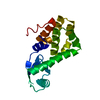+Search query
-Structure paper
| Title | Activation mechanism and novel binding sites of the BK channel activator CTIBD. |
|---|---|
| Journal, issue, pages | Life Sci Alliance, Vol. 7, Issue 10, Year 2024 |
| Publish date | Aug 1, 2024 |
 Authors Authors | Narasaem Lee / Subin Kim / Na Young Lee / Heeji Jo / Pyeonghwa Jeong / Haushabhau S Pagire / Suvarna H Pagire / Jin Hee Ahn / Mi Sun Jin / Chul-Seung Park /   |
| PubMed Abstract | The large-conductance calcium-activated potassium (BK) channel, which is crucial for urinary bladder smooth muscle relaxation, is a potential target for overactive bladder treatment. Our prior work ...The large-conductance calcium-activated potassium (BK) channel, which is crucial for urinary bladder smooth muscle relaxation, is a potential target for overactive bladder treatment. Our prior work unveiled CTIBD as a promising BK channel activator, altering and This study investigates CTIBD's activation mechanism, revealing its independence from the Ca and membrane voltage sensing of the BK channel. Cryo-electron microscopy disclosed that two CTIBD molecules bind to hydrophobic regions on the extracellular side of the lipid bilayer. Key residues (W22, W203, and F266) are important for CTIBD binding, and their replacement with alanine reduces CTIBD-mediated channel activation. The triple-mutant (W22A/W203A/F266A) channel showed the smallest shift with a minimal impact on activation and deactivation kinetics by CTIBD. At the single-channel level, CTIBD treatment was much less effective at increasing in the triple mutant, mainly because of a drastically increased dissociation rate compared with the WT. These findings highlight CTIBD's mechanism, offering crucial insights for developing small-molecule treatments for BK-related pathophysiological conditions. |
 External links External links |  Life Sci Alliance / Life Sci Alliance /  PubMed:39089879 / PubMed:39089879 /  PubMed Central PubMed Central |
| Methods | EM (single particle) |
| Resolution | 3.9 Å |
| Structure data | EMDB-39753, PDB-8z3s: |
| Chemicals |  PDB-1l04:  ChemComp-Y01:  ChemComp-MG:  ChemComp-CA: |
| Source |
|
 Keywords Keywords | MEMBRANE PROTEIN / BKca channel / Slo1 / CTIBD |
 Movie
Movie Controller
Controller Structure viewers
Structure viewers About Yorodumi Papers
About Yorodumi Papers





 homo sapiens (human)
homo sapiens (human)